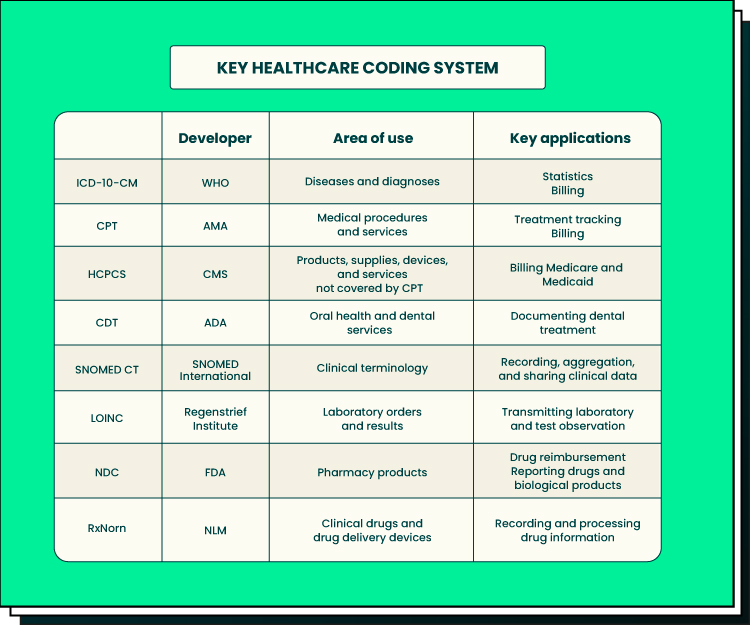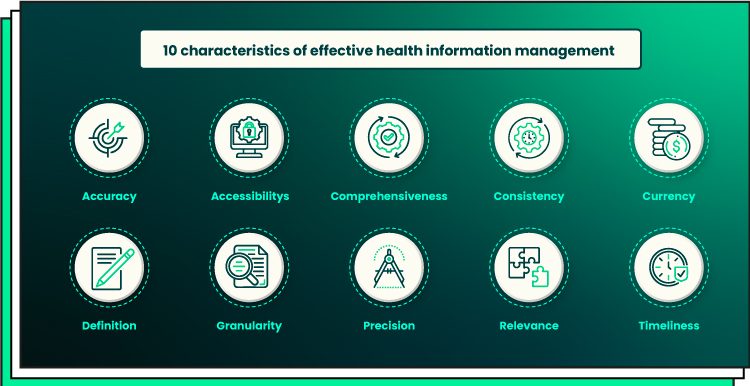The term “Health Information Management (HIM)” stands for itself. It’s applied in the healthcare industry to organize and arrange information management practices. The information managed in health care information systems is usually related to patient care, medical history, health status, etc.
Technavio projects the healthcare information management software market to grow by USD 8.75 billion by 2028, at a CAGR of 5.65%. Sounds promising, right? That growth reflects a rising demand for smarter, faster, and more secure ways to manage patient medical records. From small clinics to large hospital systems, more healthcare providers are investing in health information management software to streamline operations, reduce errors, and meet compliance standards. If you’re not exploring these tools yet, now might be the time to start.
Behind these improvements, certified professionals like the registered health information administrator play a key role. These experts ensure that health information management systems are properly implemented, data is handled securely, and regulations are consistently met. If you’re not exploring these tools yet, now might be the time to start.
In this article, we will dive into the essence of health information management and define the benefits of implementing HIM at healthcare facilities. Also, we will analyze different health information management system types and help you move to the next steps of digitizing the healthcare industry.
What Is Health Information Management and Why Does It Matter
The purpose of building health information systems is to streamline the process of acquiring, analyzing, and collecting information and improve patient care. The meaning and use of health information management software are briefly explained in the video below:
Health information management has a lot to do with health informatics. This field of science is focused on inventing methods, computational techniques, and novel technologies for collecting, processing, and analyzing clinical documentation. The data can come from various sources like electronic health records (EHR), test results, medical scans, and so on. Health informatics is where medicine meets computing and software engineering. Health information management is a part of the health informatics concept, playing a vital role in facilitating healthcare services and improving patient outcomes.
Another term related to health information management in healthcare is health information technology. It forms the core of health information management and covers the medical information technologies and tools used to enable information management and exchange. Health information management technology allows patients, health services managers, quality monitoring professionals, and other stakeholders to securely share patient information by leveraging verified types of software and hardware. Together with health informatics, health information technology aids professionals in their efforts to streamline data management in the healthcare industry.
Professionals such as the registered health information technician are central to this process. They ensure that data is accurately entered, maintained, and retrieved, supporting better clinical decisions and compliance with health regulations. Together with health informatics specialists, registered health information technicians enable healthcare teams to streamline operations and improve patient care through better data management.
Electronic Health Records (EHRs) are now used by over 90% of office-based physicians in the U.S., streamlining documentation, prescriptions, and patient communication. That adoption rate highlights just how essential EHRs have become in a modern healthcare industry. Beyond efficiency, EHRs improve care coordination, enable data-driven decisions, and reduce the risk of errors. As patient expectations grow and healthcare becomes more complex, digital recordkeeping isn’t just a nice-to-have—it’s a critical part of delivering high-quality care.
Looking to modernize your operations? Let’s talk about how the right health information management software can support your goals.
What do HIM professionals do?
Health information management professionals utilize information management systems and storage tools, develop health information policies, and identify and address the evolving needs of patients and providers to further streamline the processes. Health information management professionals work with different health records, including clinical, coded, epidemiological, financial, personal, demographic, reference data, and others.
To be more precise, the work of healthcare HIM professionals covers the following areas:
- Collect, validate, and store medical records. Health information management professionals introduce policies and procedures that regulate these processes, which increase the efficiency, quality, security, and effectiveness of health information systems.
- Analyze information and generate insights. Health information managers use the information they collect to drive insights, make predictions with big data in healthcare, create reports, enable analytics, etc., to improve patient care.
- Ensure information accessibility. HIM professionals ensure that health information is spread among healthcare providers and that they can exchange data securely.
- HIM resource management and driving innovation. This involves the management and maintenance of information sources and leveraging innovative tools for data collection across the sources.
- Health information governance and stewardship. A health information manager makes sure that the HIM in healthcare is implemented in compliance with rules and laws and that there are no security and confidentiality breaches. Also, they play a vital role in ensuring that health information is leveraged under ethical norms and organizational policies.
Below, you can see the key healthcare coding systems used by HIM professionals to regulate healthcare information management. The codes help them record, document, and report healthcare information so that other healthcare providers can leverage and interpret it.
Health Data vs Health Information: What You Need to Know
These two terms are often used interchangeably in the healthcare and medical context. However, those working with health information management in healthcare know about the difference between patient health data and information. Health data means “raw data,” like figures, numbers, medical history, or values obtained right from the source. Health information is the data after being processed or the data structured into a meaningful form. We’ll give you an example.
“25 years,” “4 p.m.,” “100/60 blood pressure,” or “Ann Green” are the pieces of raw data obtained from specific sources. After interpreting the data, healthcare professionals will get the following result: “25-year-old woman Ann Green had a blood pressure of 100/60 at 4 p.m.” This result will be treated as health information.
What Makes Healthcare Information Management Effective? 10 Traits
For effective health information management, information should be characterized by the following elements:
- Accuracy. Information should be accurate, valid, and contain correct values to ensure reliable data analysis and informed decision-making. In health information management, accuracy is essential for maintaining data integrity, meeting compliance standards, and delivering safe, high-quality patient care.
- Accessibility. Healthcare providers should be provided with the legal right to access health information. In health information management, ensuring timely and secure access to data is critical for coordinated care, quick decision-making, and improved patient outcomes.
- Comprehensiveness. Medical information leveraged in a health information management system should be exhaustive for practitioners to have a 360-degree view of the clinical situation of each patient.
- Consistency. The value and meaning of patient data should be the same across all systems for better data management and quality patient care. In health information management, consistency ensures interoperability between systems, reduces errors, and supports accurate data exchange across departments and facilities.
- Currency. Health information professionals should keep health data up to date. Health information managers play a key role in maintaining the timeliness of records, ensuring that patient information reflects the most current diagnoses, treatments, and test results for safe and effective care.
- Definition. The providers should use standard terminology and medical codes to make sure that the data is interpreted in the right way.
- Granularity. The information should be broken down into details whenever needed, each having its meaningful value.
- Precision. The value of information, as well as its format, should be compatible with the information systems for healthcare management being used.
- Relevance. A hospital information system should contain only relevant health information. Health information managers help ensure that data collected and stored is purposeful, clinically meaningful, and aligned with organizational goals, avoiding clutter and improving decision-making.
- Timeliness. Medical information should be documented timely manner, ensuring that no vital details are missed or ignored. imely documentation supports health care professionals in making accurate, real-time decisions that enhance patient safety and treatment effectiveness.
Top 6 Healthcare Information Management Systems to Know
Health information management software is designed to store, maintain, manage, and structure health information in electronic form. Some of the systems are owned by private entities and can be accessed only by the patients or healthcare providers working in that organization. Others, like patient portals, are accessible to the public.
Depending on the purpose, information systems for healthcare management can be categorized in the following ways:
Patient portals
Patient portals are health information management systems used by patients to access their health data, check their appointment history, view test results, lab results, X-rays, and medical scans, refill their prescriptions, schedule new appointments, and more. Such portals may also contain useful information on patient health, tips on how to improve healthcare outcomes, the opportunity to get in touch with a physician via the platform, etc. HIM professionals are essential in designing, managing, and maintaining these patient portals to ensure data accuracy, privacy, and ease of access.
EHR or Electronic Health Records
Electronic Health Records contain information about patient health, test results, history of treatment, history of surgeries, etc. A health management information system of this kind helps healthcare providers exchange information and keep it in order for other specialists to access it easily. Electronic medical records are gradually replacing paper-based medical records and aim to digitize the experience of both healthcare providers and patients. When combined with big data in healthcare, EHRs enable advanced analytics, helping providers identify trends, predict patient risks, and improve treatment outcomes.
Remote patient monitoring
The technological concept lying at the core of remote patient monitoring is called telemedicine. By leveraging medical sensors and special software, physicians can remotely control the state of the patient’s health and monitor critical health metrics (such as blood pressure, glucose level, etc.). They can export the patient records in real-time and share them with colleagues to facilitate the treatment with data analysis and ensure better health outcomes. HIM professionals play a vital role in managing the flow of this data, ensuring its accuracy, security, and integration into the broader health information system for continuous and coordinated care.
Master patient index
A master patient index is designed to connect multiple patient records across systems. With its help, healthcare HIM technicians ensure data integrity and consistency. By using the master patient index, the healthcare providers index all patient data registered in their organization. This also helps prevent data duplicates and gives medical providers a more comprehensive picture of the patient’s state.
Clinical decision support
This health information management system helps practitioners facilitate the decision-making process and improve patient outcomes accordingly. With the help of this software type, health information managers can analyze health data from different systems to forecast medical events and accurately diagnose based on quality patient data. HIM professionals contribute by ensuring that the data feeding into these systems is accurate, complete, and compliant, making clinical insights more reliable and actionable.
Practice management software
This health information system is designed to help health information managers automate their daily operations and tasks. They use practice management software to manage scheduling, patient appointments, billing, etc. Such software is frequently used by healthcare enterprises like hospitals or small practice facilities. Practice management software saves a lot of time and ensures quick access to all the medical records for daily practice.
Some other types of health information management systems include radiology information management systems (RISs), medical billing software, pharmacy management systems, and laboratory information management systems (LISs).
How Healthcare Information Systems Improve Patient Care
By using a health information management system, your organization gets the following benefits:
- Detecting trends and tendencies. We can talk about big data here. By analyzing and interpreting data with AI-powered medical apps, health information technicians can detect trends and tendencies in the population and their state of health. With data analysis, they forecast health situations and take preventative measures to eliminate health risks.
- Increasing efficiency. Using a health information management system can lead to significant cost savings. You can cut maintenance costs by shifting from paper-based information management to a digital format. Also, you will dramatically reduce the number of people involved in information processing and recording since most of the processes and tasks will be automated.
- Promoting collaboration. Patient health information documented on paper cannot be shared with multiple practitioners simultaneously. The spread of this information will take time and effort, not to mention the cases when some pieces of health records are lost or damaged. In contrast to this, information systems for healthcare management allow for easy information access by healthcare professionals who can discuss each case, share tips, and come up with the best formula for patient treatment. This also facilitates advancements in healthcare.
- Insights and analytics. The more information an expert has at hand, the more insightful their work is. Information management systems enable the team to collect and store health information as well as draw conclusions from it and make patient information work for their benefit.
In many healthcare facilities, professionals like the registered health information administrator play a key role in ensuring these systems are properly implemented and managed. They oversee data accuracy, compliance with regulations, and the integrity of electronic health records, helping organizations fully realize the benefits of modern health information management.
These improvements lead to greater patient satisfaction, better care quality, and more efficient operations for healthcare providers.
How Can Forbytes Help with HIM System Implementation?
In this paper, we outlined the basics of healthcare HIM to give you a solid understanding of health information management software, the benefits of HIM for healthcare organizations, and best practices for successful implementation. To fully undergo digital transformation in your medical facility or healthcare organization, you’ll need the support of niche experts who can digitize information management workflows and patient health records efficiently.
Alongside data security and compliance, data analysis plays a key role in modern HIM systems. With accurate and timely data analysis, healthcare providers can uncover insights into patient outcomes, operational inefficiencies, and population health trends, enabling smarter decisions and more personalized care.
The knowledge we share will help you choose skilled HIM technicians and consultants who have the right competencies and can address your organization’s unique challenges.
Whether you need help building a solution from scratch or configuring an off-the-shelf system, Forbytes can help. We handle data encryption, data backup, data migration, database preparation, compliance management, software integration, and assist with data management strategy. With multifactor authentication, access control, and other advanced security measures, we ensure your software is safely integrated and effectively leveraged within your business infrastructure.
Contact us to discover how our tailored solutions can meet your specific healthcare management and data analysis needs.










